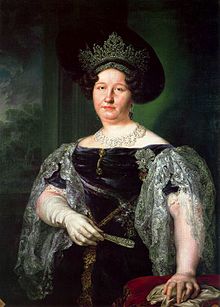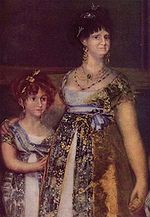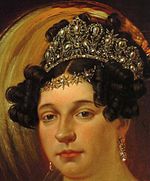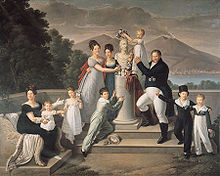- María Isabella of Spain
-
María Isabella of Spain Queen of the Two Sicilies 
Portrait of The Queen by Vicente López y Portaña Consort 4 January 1825–8 November 1830 Spouse Francis I of the Two Sicilies
Francis, Count of BalzoIssue Luisa Carlotta, Infanta of Spain
María Cristina, Queen of Spain
Ferdinand II of the Two Sicilies
Carlo Ferdinando, Prince of Capua
Leopold, Count of Siracusa
Maria Antonia, Grand Duchess of Tuscany
Antonio, Count of Lecce
Maria Amalia, Infanta of Portugal and Spain
Maria Carolina, Countess of Montemolin
Teresa Cristina, Empress of Brazil
Luigi, Count of Aquila
Francesco, Count of TrapaniHouse House of Bourbon
House of the Two SiciliesFather Charles IV of Spain Mother Maria Luisa of Parma Born 6 July 1789
Madrid, SpainDied 13 September 1848 (aged 59)
Palace of Portici, Two SiciliesBurial Basilica of Santa Chiara, Naples Religion Roman Catholic María Isabella of Spain (6 July 1789 – 13 September 1848) was an Infanta of Spain and the Queen of the Two Sicilies. She was the second wife of Francis I and the youngest surviving daughter of the Spanish king Charles IV and his consort Maria Luisa of Parma. She had twelve children.
Contents
Family
 Detail of Goya's portrait Charles IV of Spain and His Family: María Isabella, aged 10–11, with her mother
Detail of Goya's portrait Charles IV of Spain and His Family: María Isabella, aged 10–11, with her mother
María Isabel de Borbón y Borbón-Parma was the youngest surviving daughter of King Carlos IV of Spain (1748–1819) and his wife Maria Luisa of Parma (1751–1819), a granddaughter of Louis XV of France. Her paternal grandparents were Charles III of Spain and Maria Amalia of Saxony. Her maternal grandparents were Philip, Duke of Parma and Princess Louise Élisabeth of France. Her grandfathers were brothers, both sons of Philip V of Spain and his second wife Elisabeth Farnese.
María Isabel's father had a great frame and immense physical strength, and a reputation for performing acts of kindness, but was considered by many to be intellectually sluggish and quite credulous. Even though he kept up the appearance of an absolute, powerful monarch, he never took more than a passive role in the direction of his own kingdom, instead leaving the affairs of government to his wife and prime minister. Her mother was often described by contemporaries as a vicious woman who thoroughly dominated the king.
María Isabel and her family members were painted by Francisco Goya in his 1800–01 portrait Charles IV of Spain and His Family. All four daughters of Charles IV (Carlota, Maria Amalia, Maria Luisa and María Isabel) were short and plain.[1]
Marriage
In 1802, María Isabel married the Duke of Calabria, Prince Francesco of Naples and Sicily, while her eldest brother Infante Fernando, Prince of Asturias, married Francesco's sister Maria Antonia. The prince royal was her first cousin, the eldest son of Ferdinand, King of Sicily (as Ferdinand III) and Naples (as Ferdinand IV), her father's younger brother, and Maria Carolina of Austria, a sister of Marie Antoinette. On her thirteenth birthday (6 July 1802) in Barcelona, María Isabel married Francesco by proxy, as his second wife; he had previously been married to his double cousin Maria Clementina of Austria, who had died in 1801. María Isabel, in Italian Maria Isabella, was sent to Naples to meet her husband and a second marriage ceremony took place there on 19 August 1802. This time the thirteen-year-old bride and 25-year-old groom were married in person.
Upon her arrival at the court of Naples María Isabel did not cause a good impression. She looked even younger than her thirteen years and was described as " little, and round as a ball". [2]Her mother-in-law, Queen Maria Carolina, had been close to her son's first wife, who was also her niece. She had an unfavorable first impression of the young María Isabella, about whom she wrote the following:
A fine, fresh, healthy face, not Bourbon in the least, but white and red, with black eyes. She is very stout and sturdy, yet her legs are very short. So much for her exterior. The rest cannot be described because I myself cannot understand it. She is null in every respect, knowledge, ideas, curiosity. Nothing, absolutely nothing. She speaks a little Spanish but neither Italian nor French, and only monosyllables, Yes or No, indiscriminately. She smiles all the time, whether she is pleased or not...Francis's child aged four has far more intelligence. Francis has engaged masters to teach her Italian and the rudiments of geography and arithmetic. She knows nothing except little piano. I have tried to praise and enliven her. She feels nothing; she laughs. She is an automaton which might acquire certain attitudes but never real maturity. Were I the ambitious, intriguing woman I am said to be, I should be enchanted to have such a daughter in law who will never become anything, but I am too conscientious for that. I tried every means to mold her as a companion for her husband, even if this may turn her against myself. Believe me this child is a tight present, for she will neither ennoble nor improve our race. All the numerous Spanish clique, all their projects and schemes, have received a knock out blow by the arrival of this Princess and her perfect nullify..[3]María Isabella, as she was then called, also became a stepmother. Francis' only surviving child from his first marriage, Princess Carolina of Naples and Sicily, would marry the French-born Duke of Berry (the second son of King Charles X of France) and become famous as Madame de Berry.
Her brother and sister-in-law were married on 4 October 1802 in Barcelona. However, Maria Antonia was deeply disillusioned with her husband, who was ugly and bad-mannered. In a letter to one of her friends, Queen Maria Carolina wrote of the Prince of Asturias: "He is disagreeable, dull, as lazy as his sister..."
In 1806, her father-in-law Ferdinand was deposed as King of Naples by Napoleon Bonaparte. He and Maria Carolina retained their status and power in Sicily until 1812, when he essentially (but not officially) abdicated, appointing Francis regent, which deprived the queen of her influence. In 1813 Maria Carolina was exiled to her homeland Austria, where she died in 1814. On 4 January 1825, Ferdinand died and Francis succeeded to the throne with María Isabella serving as his Queen consort. Her husband reportedly took little part in the government, which he left in the hands of favourites and police officials, and lived with his mistresses, surrounded by soldiers, ever in dread of assassination. He died on 8 November 1830.
Issue
Francis and María Isabella were well match and he treated her with kindness.[3] They had twelve children, six daughters and six sons.
- Princess Luisa Carlotta (1804–1844), married her mother's younger brother Francis of Paola, Infante of Spain.
- Princess María Cristina Ferdinanda (1806–1878), married firstly her mother's older brother Ferdinand VII of Spain, and secondly Ferdinand Muñoz, Duke of Rianzares.
- Ferdinand II of the Two Sicilies (1810–1859), became Francis I's successor and married twice.
- Carlo Ferdinando, Prince of Capua (1811–1862), married morganatically to Penelope Smyth and had issue.
- Leopoldo, Count di Siracusa (1813–1860), married Princess Maria of Savoy, had no issue.
- Princess Maria Antonia Giuseppa Anna (1814–1898), married Leopold II, Grand Duke of Tuscany.
- Princess Maria Amalia (1818–1857), married Infante Sebastian of Portugal and Spain.
- Princess Maria Carolina Ferdinanda (1820–1861), married Infante Carlos of Spain, Count of Montemolin and Carlist pretender to the throne of Spain, had no issue.
- Princess Teresa Cristina Maria Giuseppa Gaspare Baltassare Melchiore Gennara Francesca de Padova Donata Bonosa Andrea d'Avelino Rita Luitgarda Geltruda Venancia Taddea Spiridione Rocca Matilde (1822–1889), married Emperor Pedro II of Brazil, had issue.
- Prince Luigi Carlo Maria Giuseppe, Count of Aquila (1824–1897), married Januária Maria, Princess Imperial of Brazil (sister of Pedro II and Maria II of Portugal), had issue.
- Prince Francesco di Paola, Count of Trapani (1827–1892), married Archduchess Maria Isabella of Austria, Princess of Tuscany and had issue.
Late years
María Isabella remained a widow for nine years. On 15 January 1839, María Isabella married her second husband Francis, Count of Balzo (1805–1882); she was 50 years old and the groom, 34.
Ancestors
Ancestors of María Isabella of Spain 16. Louis, Dauphin of France 8. Philip V of Spain 17. Maria Anna of Bavaria 4. Charles III of Spain 18. Odoardo II Farnese 9. Elisabeth Farnese 19. Dorothea Sophie of the Palatinate-Neuburg 2. Charles IV of Spain 20. Augustus II of Poland 10. Augustus III of Poland 21. Christiane Eberhardine of Brandenburg-Bayreuth 5. Maria Amalia of Saxony 22. Joseph I, Holy Roman Emperor 11. Maria Josepha of Austria 23. Wilhelmina Amalia of Brunswick 1. María Isabella Spain 24. Louis, Dauphin of France (= 16) 12. Philip V of Spain (= 8) 25. Maria Anna of Bavaria (= 17) 6. Philip, Duke of Parma 26. Odoardo II Farnese (= 18) 13. Elisabeth Farnese (= 9) 27. Dorothea Sophie of the Palatinate (= 19) 3. Maria Luisa of Parma 28. Louis of France, Duke of Burgundy 14. Louis XV of France 29. Princess Maria Adelaide of Savoy 7. Marie Louise Élisabeth of France 30. Stanisław Leszczyński 15. Marie Leszczyńska 31. Catherine Opalińska Titles, styles, honours and arms
Titles and styles
- 6 July 1789 – 6 July 1802 Her Royal Highness the Infanta Doña María Isabella
- 6 July 1802 – 4 January 1825 Her Royal Highness the Duchess of Calabria
- 4 January 1825 – 8 November 1830 Her Majesty the Queen of the Two Sicilies
- 8 November 1830 – 13 September 1848 Her Majesty the Dowager Queen of the Two Sicilies
Notes
References
- Acton, Harold. The Bourbons of Naples (1734-1825). Prion books limited, London, 1989 (first published in 1957). ISBN 1-85375-291-6
- Bearne, Catherine Charlton. A Royal Quartette.
- Rubio, Maria José. Reinas de España. La Esfera de los Libros, Madrid, 2009. ISBN 978-84-9734-804-1
External links
 Media related to Maria Isabella of Spain at Wikimedia Commons
Media related to Maria Isabella of Spain at Wikimedia CommonsSee also
The generations indicate descent form Charles I, under whom the crowns of Castile and Aragon were united, forming the Kingdom of Spain. Previously, the title Infanta had been largely use in the different realms. 1st Generation Maria, Holy Roman Empress · Joan, Princess of Portugal2nd Generation Isabella Clara Eugenia, Co-sovereign of the Habsburg Netherlands · Catherine Michelle, Duchess of Savoy · Infanta Maria3rd Generation 4th Generation Infanta María Margarita · Infanta Margarita María · Infanta Maria Eugenia · Infanta Isabel María · Infanta Mariana · Maria Theresa, Queen of France · Margarita Teresa, Holy Roman Empress · Infanta Maria Ambrosia5th Generation none6th Generation none7th Generation 8th Generation Infanta Maria Isabel · Infanta Maria Josefa · Infanta María Isabel Ana · Infanta Maria Josepha · Maria Luisa, Holy Roman Empress · Infanta Maria Teresa · Infanta Maria Ana9th Generation Carlota Joaquina, Queen of Portugal · Infanta Maria Luisa · Infanta Maria Amalia · Maria Louisa, Queen of Etruria · Maria Isabella, Queen of the Two Sicilies · Infanta Maria Teresa10th Generation Isabella II · Luisa Fernanda, Duchess of Montpensier · Maria Luisa, Crown Princess of Saxony* · Isabella, Countess Ignaz Gurowski* · Luisa, Duchess of Sessa* · Infanta Josefina, Mrs. José Guëll* · Infanta Maria Cristina* · Amelia Philippina, Princess Adalbert of Bavaria*11th Generation Isabella, Princess of Asturias · Infanta Maria Cristina · Maria de la Concepcio · Maria de Pilar · Maria de la Paz, Princess Louis Ferdinand of Bavaria · Eulalia, Duchess of Galliera · Maria Isabella, Countess of Paris* · Infanta Amalia of Orléans* · Infanta Cristina d'Orléans* · Infanta Maria de la Regla of Orléans* · Mercedes, Queen of Spain*12th Generation Mercedes, Princess of Asturias · Maria Teresa, Princess Ferdinand of Bavaria13th Generation Beatriz, Princess of Citivella-Cesi · Maria Cristina, Countess of Marone · Isabel Alfonsa, Countess Jan Kanty Zamoyski* · Mercedes, Princess Bagration of Mukhrani* · Infanta Pilar of Bavaria*14th Generation 15th Generation 16th Generation *title granted by Royal Decree 1st Generation Infanta María Isabella of Spain · Archduchess Clementina of Austria2nd Generation Princess Maria Vittoria of Savoy · Januária Maria, Princess Imperial of Brazil · Archduchess Maria Isabella of Austria3rd Generation Duchess Maria Sophie in Bavaria · Duchess Mathilde Ludovika in Bavaria · Princess Maria Antonietta of Bourbon-Two Sicilies* · Isabella, Princess of Asturias4th Generation Princess Maria Ludwiga Theresia of Bavaria · Mercedes, Princess of Asturias · Princess Louise of Orléans · Beatrice, Countess of Villa Colli · Countess Maria Carolina Zamoyska · Princess Marie Louise of Orléans · Princess Malgorzata Izabella Czartoryska · Princess Cecylia Lubomirska5th Generation Princess Alicia of Parma · Chantal de Chevron-Villette** · Duchess Elisabeth of Württemberg · Princess Maria Cristina of Savoy6th Generation Princess Anne of Orléans · Countess Alexandra of Schönborn-Wiesentheid · Camilla Crociani** · Christine Apovian**7th Generation Sofía Landaluce***also a princess of the Two Sicilies in her own right
**did not have a royal or noble title by birthRoyal consorts of the Two Sicilies Caroline Bonaparte (1808–1815) · Infanta María Isabella of Spain (1825-1830) · Princess Maria Cristina of Savoy (1832–1836) · Archduchess Maria Theresa of Austria (1837–1859) · Duchess Maria Sophie in Bavaria (1859)Categories:- 1789 births
- 1848 deaths
- People from Madrid
- House of Bourbon (Spain)
- House of Bourbon-Two Sicilies
- Spanish infantas
- Princesses of Bourbon-Two Sicilies
- Royal consorts of the Two Sicilies
- Burials at the Basilica of Santa Chiara
- Spanish Roman Catholics
- Duchesses of Calabria
- Dames of the Order of Queen Maria Luisa
Wikimedia Foundation. 2010.


